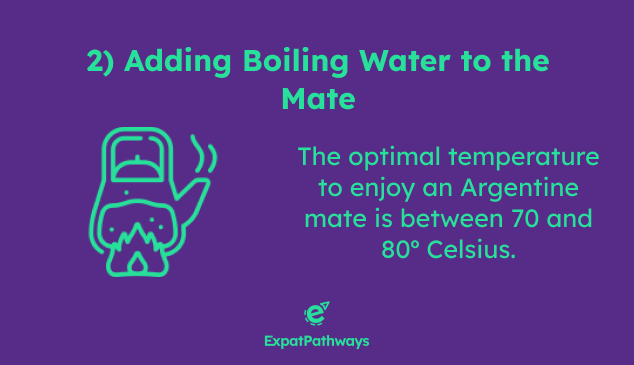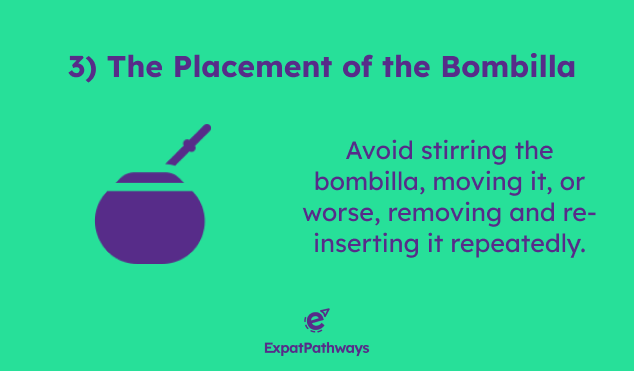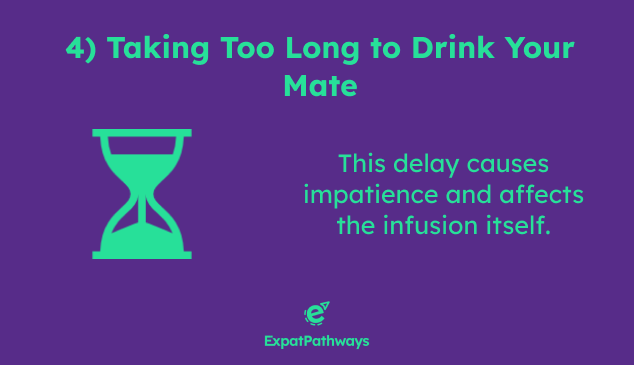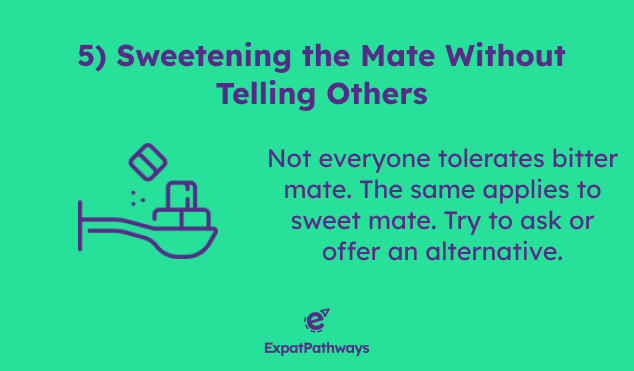No Argentine mate book or manual is more reliable than the recommendations of a Buenos Aires native. Keep in mind that Argentines consume an average of 6.4 kg of yerba mate per inhabitant per year. This reflects the extent to which mate is part of our daily lives.
Just as Colombians, Brazilians and Central Americans can teach good coffee, the same goes for Argentine mate. For a good mate, nothing better than an Argentinian who knows how to guide a beginner not only in the preparation, but also in what things to avoid so that the experience is not disappointing.
Here we go with the typical and common mistakes that we must avoid so that the Argentine mate does not become a nightmare. Let us begin!
Argentine Mate: Beginner Mistakes You Should Avoid
First Mistake: Filling the Mate Cup to the Brim

One of the most common beginner mistakes is filling the mate cup with yerba mate to the brim.
Keep in mind that yerba mate expands when it comes into contact with hot water and gains a lot of volume. Therefore, if it’s filled to 100%, the contents will overflow, and the following will happen:
- An endless and lengthy mate, which is not recommended, especially when participating in mate rounds where everyone drinks and shares.
- A high likelihood of the bombilla (straw) getting blocked, making it impossible to sip the water.
- In the case of a small mate cup filled to the brim, the water will barely be able to enter, resulting in a very short mate.
The mate cup should be filled to a maximum of 50% of its total capacity. Additionally, when you add water (a process called “cebar el mate”), you should not fill it to the top of the cup. Again, an excessively long mate becomes boring.
Second Mistake: Adding Boiling Water to the Mate

The water temperature for Argentine mate… a real dilemma. We won’t be too strict here: some enjoy Argentine mate at the minimum ideal temperature (70º Celsius), while others prefer it as hot as possible within reason.
However, when the water temperature exceeds the maximum ideal limit of 80º Celsius, there’s no debate: that mate will not only be excessively hot and difficult to drink (you’ll burn yourself), but it will also taste very bitter.
Why do some mates taste so bitter? One of the main reasons, besides the type of yerba mate used, is that the water is above the optimal limit, or worse, boiling.
Remember that the optimal temperature to enjoy an Argentine mate is between 70 and 80º Celsius. Within this temperature range, you’ll enjoy a rich, frothy mate at just the right temperature, without burning your tongue or feeling it cold.
Both boiling water and water below the optimal temperature ruin the mate and turn it into an infusion that is impossible to drink.
Third Mistake: The Placement of the Bombilla

The instinct of a beginner mate drinker is to consider the bombilla as equivalent to a straw for a smoothie, soda, or milkshake. This results not only in poor placement of the bombilla in the mate but also in a manipulation that will horrify many Argentinians and mate enthusiasts.
When preparing an Argentine mate, the bombilla should be placed after adding the yerba mate, not before. To give you a practical idea, it’s like sticking a beach umbrella into the sand. Here’s a brief step-by-step guide to do it successfully:
- Add the yerba mate to the mate cup up to 50% (maximum) of its capacity.
- Carefully, covering the mouth of the mate cup (with your hand or a napkin), tilt it down and shake it like a cocktail shaker. This helps to remove as much dust as possible that could clog the bombilla.
- Return the mate cup to its normal position and ensure the yerba mate forms a slope inside the mate.
- On the side where the yerba mate slope descends, add a splash of warm water to moisten and prepare the yerba.
- In that exact spot where you added the warm water, insert the bombilla, trying to position it along the wall of the mate cup and slightly tilting the lower part (already inserted in the mate) towards the center.
Additionally, avoid stirring the bombilla, moving it, or worse, removing and re-inserting it repeatedly as if it were a straw in a chocolate shake.
Fourth Mistake: Taking Too Long to Drink Your Mate

Think of Argentine mate as an infusion taken in turns. Each turn has a maximum duration, after which you should have finished and returned it so that others can continue drinking. “Hurry up, mate is not a microphone.” This is a common phrase when Argentinians see someone taking too long with the mate and not finishing it.
This delay not only causes impatience among others who want to drink mate (when in a mate round or drinking with others) but also affects the infusion itself, altering the flavor, temperature, and even the longevity of the yerba mate.
When you receive the mate, make sure to drink it in sips and don’t prolong your turn. This doesn’t mean you should rush through it, as that wouldn’t allow you to enjoy it either. The goal is to prevent the mate round from being too slow and the early deterioration of the drink.
Fifth Mistake: Sweetening the Mate Without Informing Others

Not everyone can tolerate bitter mate. Sometimes, the variety of yerba mate used may not be very smooth to the palate and requires an adjustment period for our taste buds to get used to the unfamiliar flavor.
However, it can also happen that even with regular consumption, you don’t develop a taste for bitter mate. This is normal, and many mate enthusiasts prefer to sweeten it, either with a sweetener or sugar.
The mistake is not in your freedom to drink sweet or bitter mate, but in adding sugar or sweetener to a mate shared with others. It’s even worse if the sweetener is added to the hot water used to prepare the mate, as it becomes impossible to avoid the sweetness.
Relax, because this mistake is easily avoidable and even negotiable if you take these precautions:
- If you want to add an artificial sweetener directly to the mate water, prepare two separate thermos flasks of hot water. One with the sweetener and the other without.
- If you don’t want to prepare two thermos flasks of hot water or only have one, and others will be drinking the mate, clearly ask: Bitter or sweet?
- Based on the responses, another option is to add sugar or sweetener to the mate cup itself when one of the consumers requests it.
- Keep in mind that, especially in the case of sugar, the sweet taste will only be noticeable from the second or third mate after it has been added.
- Another option is to prepare two separate mate cups. One for those who enjoy bitter mate, and the other for those who want to add sugar or sweetener.
But the most important mistake you should avoid at all costs is giving a sweet mate to someone who prefers bitter mate, and the same in reverse. For many mate consumers and enthusiasts, this can be considered a sacrilege.
Sixth Mistake: Saying “Thank You” When Returning the Mate

Is it wrong to thank the person who prepared and served a mate? Not at all! It’s not a matter of courtesy or rudeness, but a matter of custom.
Like any ritual, mate has its own language and set of codes. Of course, a foreigner won’t fully understand the meaning of these codes until they experience it firsthand.
One of the most “unintentional” mistakes in the context of a mate round is saying “thank you” when returning your mate after finishing it. Why?
In the language of Argentine or Río de la Plata mate, saying “thank you” when returning your mate means that you don’t want any more. In a regular conversational setting, thanking someone is synonymous with politeness and gratitude, but in the context of mate and its ritual, “thank you” implies you’re satisfied.
In fact, many people (even Argentinians) are surprised when they return the mate and are then omitted in the following rounds. That’s when they ask in surprise: “Why didn’t you give me mate?” or “Hey, am I invisible?” What possibly happened is that the person said “thank you” without realizing it, and the mate server understood that they didn’t want any more.
Remember: only say “thank you” when returning your mate if you’re satisfied. Otherwise, you’ll be considered out of the round.
(Featured Image Source: freepik/freepik.com)


